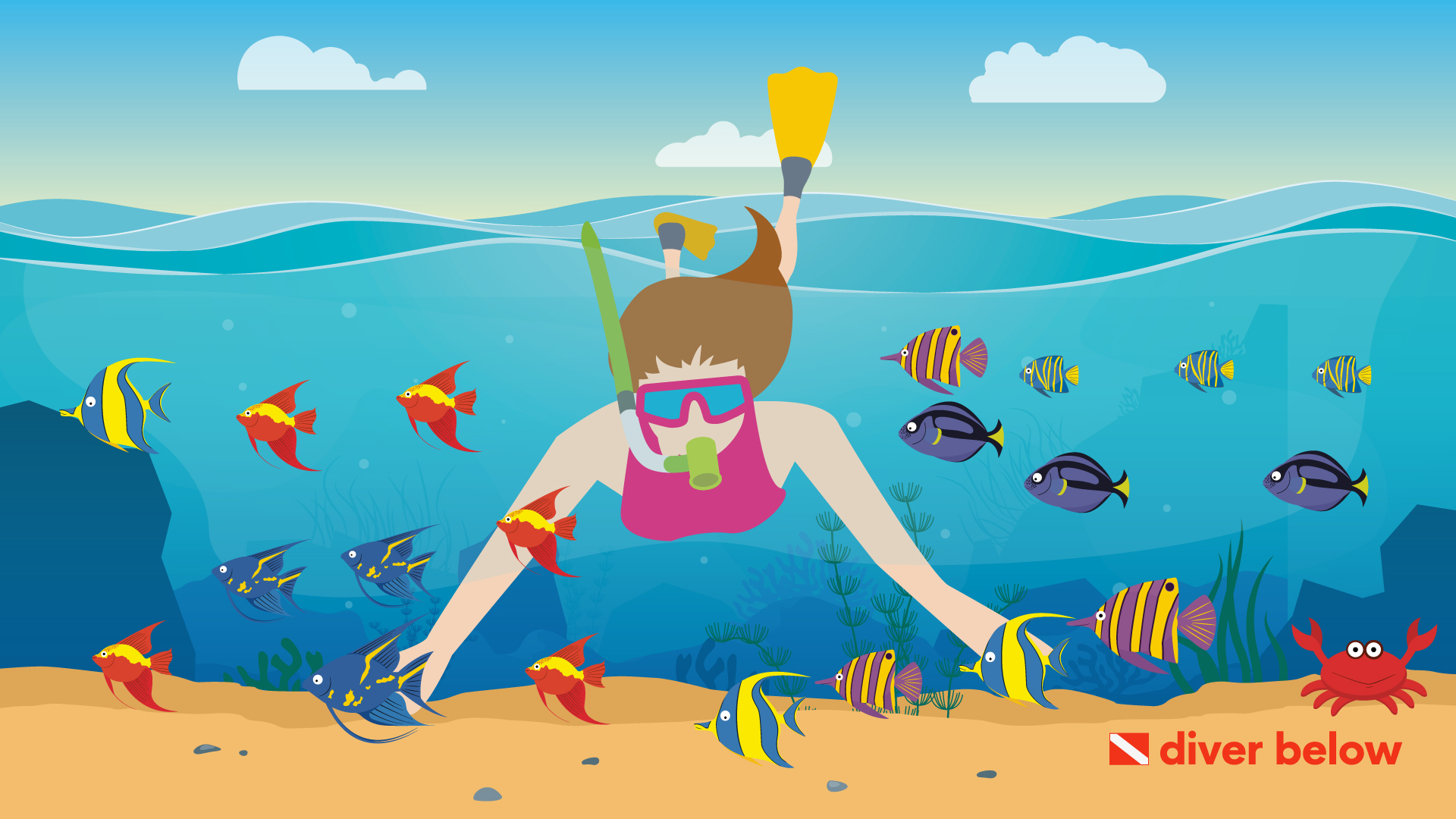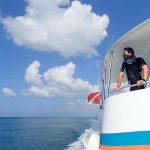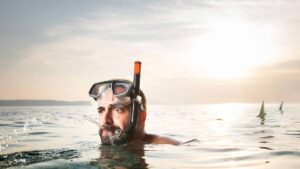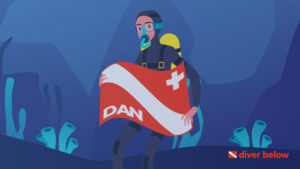It’s crazy to think that, with just a few pieces of equipment, you can view an entirely different world thriving beneath the ocean’s waves.
Whether you’re interested in spotting colorful sea life, participating in a great family activity on vacation, or simply enjoying being in the sea, snorkeling is an easily accessible activity that offers a little bit of everything.
Contents
What is Snorkeling?
Snorkeling is one of those activities that might seem difficult to define.
To keep things simple, we define snorkeling as an aquatic activity where a person generally stays at the surface of the body of water in which they swim while using a:
- Mask
- Snorkel
- Fins
- Buoyancy vest
What sets snorkeling apart from scuba diving or skin diving is the swimmer’s tendency to stay at or near the surface of the water.
Although some snorkelers use a flotation device, like a vest, to help them glide effortlessly through the water, snorkelers don’t use an oxygen tank.
How Does Snorkeling Work?
Swimmers use snorkel gear, such as a mask, fins, and a snorkel, to view the underwater world.
In particular, a snorkel makes it possible for swimmers to peer underwater uninterrupted by breathing through a tube that remains above water.
A snorkel has a mouthpiece that connects to a j-shaped breathing tube long enough to stay above water while the snorkeler’s face is submerged.
The tube grants the snorkeler access to air so they may view the underwater world uninterrupted.
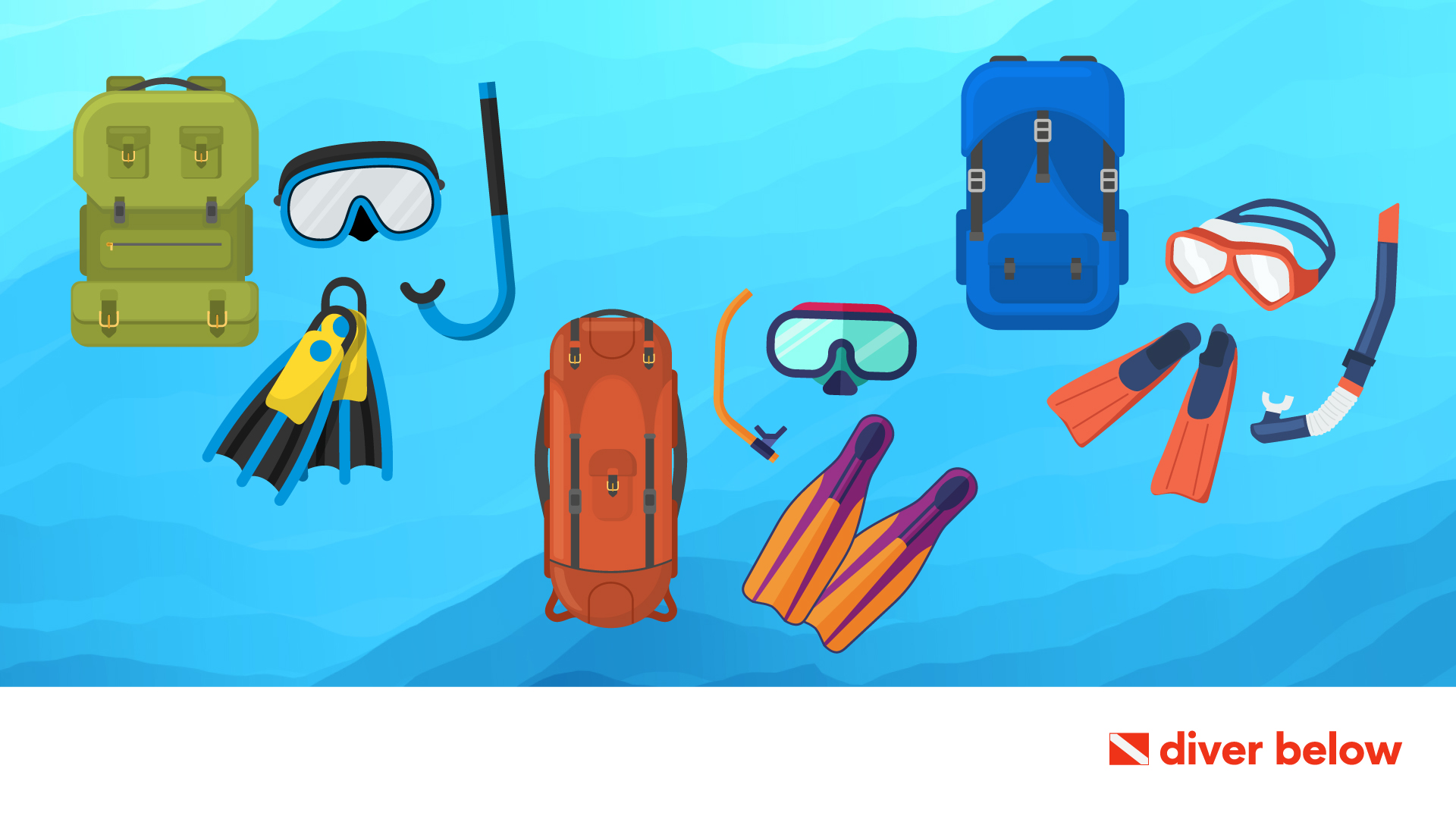
Classic Snorkels
Classic snorkels tend to have the bare-minimum features necessary to comfortably and safely snorkel.
These features include a tube, mask clip, and mouthpiece.
The mask clip allows the snorkel to be attached to a mask strap to keep the tube upright.
Modern Snorkels
Modern snorkels have the essential features necessary to snorkel and additional features to make the experience more comfortable and convenient.
The additional features might include:
- A splash guard at the topmost part of the snorkel to prevent waves or other swimmers from getting water into the breathing tube
- A flexible tube close to the mouthpiece that reduces jaw fatigue
- A purge valve at the bottom part of the snorkel, which allows water that has entered the breathing tube to drain
- A float valve, which prevents water from entering the tube if the entire snorkel is submerged
When Did Snorkeling Begin?
Snorkeling has a surprisingly ancient history.
Greek sponge farmers in 3000 BC used hollow reeds as the first known snorkels used by humanity.
As time passed, other civilizations came up with technology to help them brave the depths of the ocean and experience the underwater world in an entirely new way.
From Assyrian divers filling animal skins with oxygen in around 900 BC to the invention of the first diving bell in 333 BC, ancient people were no less fascinated by underwater landscapes.
Who Can do Snorkeling?
Snorkeling is a water sport that’s accessible for most healthy people.
Even children, with proper adult supervision, can go snorkeling.
If you’re a non-swimmer, it’s still possible and safe to snorkel!
You can use a snorkeling vest or a regular life vest to help you float across the water.
Snorkeling doesn’t need to be done in deep water, either.
You can stick to shallow water to test out how comfortable you feel in the life vest before heading out on a snorkeling adventure in deeper water.
If you have a severe medical condition, you’ll want to consult your doctor before attempting to snorkel, or you’ll want to avoid the activity altogether.
Regular smokers should also consider whether they’re healthy enough to snorkel.
Snorkeling can pose issues for people with respiratory problems since the activity involves breathing through a tube.
If you’re comfortable with snorkeling regardless, you should still avoid having a cigarette an hour or so before you get started.
Reasons to Snorkel
Whether you’re on vacation and want a fun family activity to do together or you’re fascinated by underwater wildlife, there are so many reasons to try snorkeling!
1. See Marine Life
It isn’t often that we, as humans, get to witness how an entire ecosystem lives up close and personal.
Depending on where you decide to go snorkeling, you might see dolphins, sea turtles, whale sharks, jellyfish, and hundreds of different species of tropical fish.
Many snorkelers enjoy going to a coral reef to witness unbelievably colorful ecosystems jam-packed with life.
2. Photography
Underwater photography not only poses new and exciting challenges to experienced photographers but can be an incredible way to remember a family vacation.
You can buy a fun disposable waterproof camera to take with you on your snorkeling adventure and snap some photos of your loved ones on the trip.
Snorkeling Equipment: What You’ll Need
There are a few essential pieces of equipment you’ll need to start snorkeling.
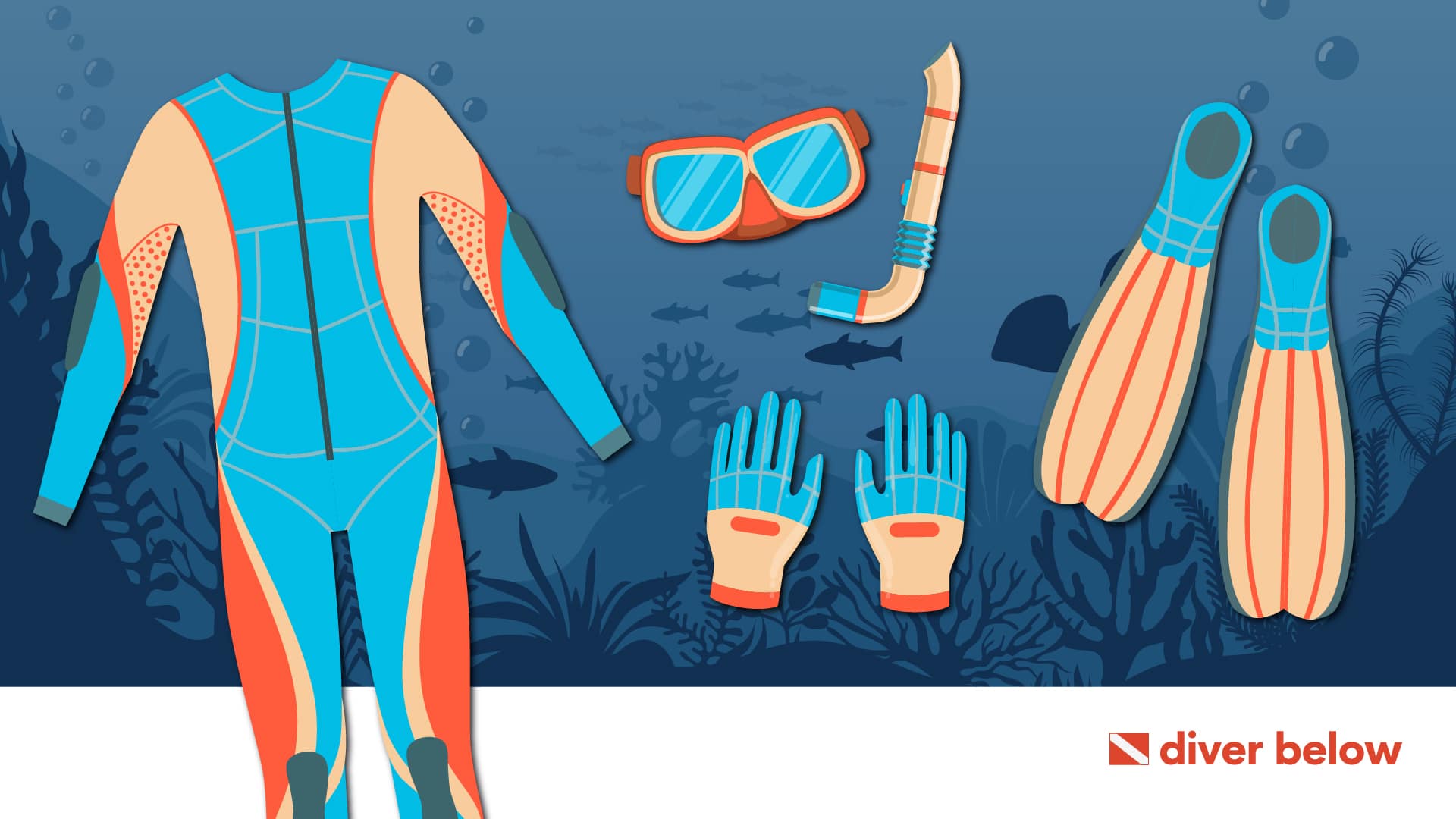
Mask
A snorkeling mask allows you to witness the beauty of the underwater world.
Even if you’re a beginner, you’ll want to invest in a high-quality snorkeling mask.
A high-quality mask should be made of suitable materials and fit your face well, so you won’t experience any leaks or breaks while snorkeling.
A mask made with tempered glass is the best choice.
Traditional Snorkeling Mask
Whether you’d prefer a traditional or full-face mask is up to your personal preferences.
Traditional snorkeling masks have more function beyond casually viewing underwater landscapes as a beginner.
As you continue to develop your snorkeling skills, you may find that you want to dive deeper underwater to get a closer look at life beneath the waves.
In this case, you can’t use a full-face mask.
Instead, the traditional snorkeling mask is needed to help you equalize pressure build-up in your ears.
Full-Face Mask
Full-face masks, sometimes called EasyBreath masks, became popular for their comfort.
These masks allow you to breathe easier through both your nose and mouth.
There are tons of different brands available online or at your local diving store.
Before buying a full-face mask, be sure to read over the safety concerns associated with using one.
Prescription Snorkeling Mask
If you wear glasses to help sharpen your vision, you might worry about not having a clear image when you go snorkeling for the first time since you can’t wear glasses underneath your mask.
Luckily, you can order a prescription snorkeling mask that is both high-quality and allows you to have the most transparent, sharpest image of underwater life possible.
Dry Snorkel
If you’re planning to buy a full-face snorkel mask, the dry snorkel comes built-in.
With a traditional mask, you’ll need to purchase a dry snorkel to go with it.
A dry snorkel is what allows snorkelers to continue to breathe while their head or face is underwater.
It’s a j-shaped tube with a mouthpiece and a long tube that reaches above your head and stays above water.
Traditional dry snorkels were made of stiff materials and caused jaw fatigue easily, but technology and innovation in the snorkeling industry have come a long way since then.
Now, you can buy a flexible dry snorkel that fits comfortably and prevents water from getting in the tube.
Fins
In some cases, you can get away with snorkeling without wearing fins.
Like what you’ll find closest to the shore, shallow water without a current generally doesn’t require fins.
However, if you’re snorkeling in open water or water with a current, it’s imperative to be equipped with a pair of snorkeling fins.
The fins allow snorkelers to safely swim in currents and travel between coral reefs and shallow water.
Rash Guard
A rash guard, sometimes called a swim shirt, protects your body from harmful UV rays while you’re in the water.
A rash guard is generally made from spandex, nylon, or polyester to keep the shirt lightweight for swimming.
If you’re planning on spending a lot of time out snorkeling, it’s a good idea to invest in a rash guard to protect you from sunburn.
Don’t confuse a rash guard with a wet suit.
Rash guards are lightweight, typically only worn on the top half of the body, and only protect against harmful UV rays.
A wetsuit, on the other hand, is intended to insulate a swimmer from freezing cold water.
A wetsuit can be a rash guard in the sense that it protects the body from harmful UV rays, but a rash guard cannot be a wetsuit.
How to Snorkel
Snorkeling might seem like a straightforward activity, but it involves a few skills you’ll need to master over time.
How Deep to Go When Snorkeling
Some snorkelers only want to stay at the surface of the water, and that’s perfectly okay.
Even at the surface, there’s so much of the underwater world to see and enjoy.
However, if you find yourself wanting to get a closer look at what’s beneath you, you can dive even while snorkeling.
Before you start diving deeper while snorkeling, it’s crucial to understand how deeper water will affect your body.
If you’ve ever tried to carry a whole bucket of water, then you already know that water is heavy.
One cubic foot of water weighs close to 62.4 pounds.
So it’s safe to say that as you travel deeper underwater, your body will experience a more significant amount of pressure.
Snorkelers tend only to dive between 1 to 2 meters (3 – 6 feet) underwater.
If you’re new to snorkeling, it’s best to get comfortable between 1 to 3 feet before trying to go any deeper.
Be aware that your face mask will feel tighter the deeper you go.
How to Breathe When Snorkeling
The best way to breathe when snorkeling is through slow, deep breaths.
If you’re new to snorkeling, you might want to practice how to breathe with the dry snorkel in shallow water before you start exploring.
Be sure to wear your mask so you can adjust to the overall feeling.
First, you’ll want to bite the mouthpiece of your snorkel and seal your lips around it so that no water can get in.
You can take a slow, deep breath before you submerge your face underwater to have a clear underwater image with your mask, but the tube of your snorkel stays above water.
On an exhale, you’ll want to exhale through your nose, which will release bubbles of CO2.
Inhale slowly and deeply through the mouthpiece.
Try this a few times to get your rhythm.
How to Swim When Snorkeling
Non-swimmers can rely on a flotation device, like a snorkeling vest or lifejacket, to glide through the water while snorkeling.
For those who know how to swim, there’s a technique you can practice to help you snorkel better.
A swimming instructor would call the swimming technique favored by most snorkelers the ‘freestyle’ stroke.
The freestyle stroke, also called the front crawl, is one of the most efficient swimming techniques.
By using both your arms and legs, you can glide quickly through the water, especially with the help of your snorkel fins.
Tips for Snorkeling
There are a few things you’ll want to keep in mind to help you get the most out of snorkeling.
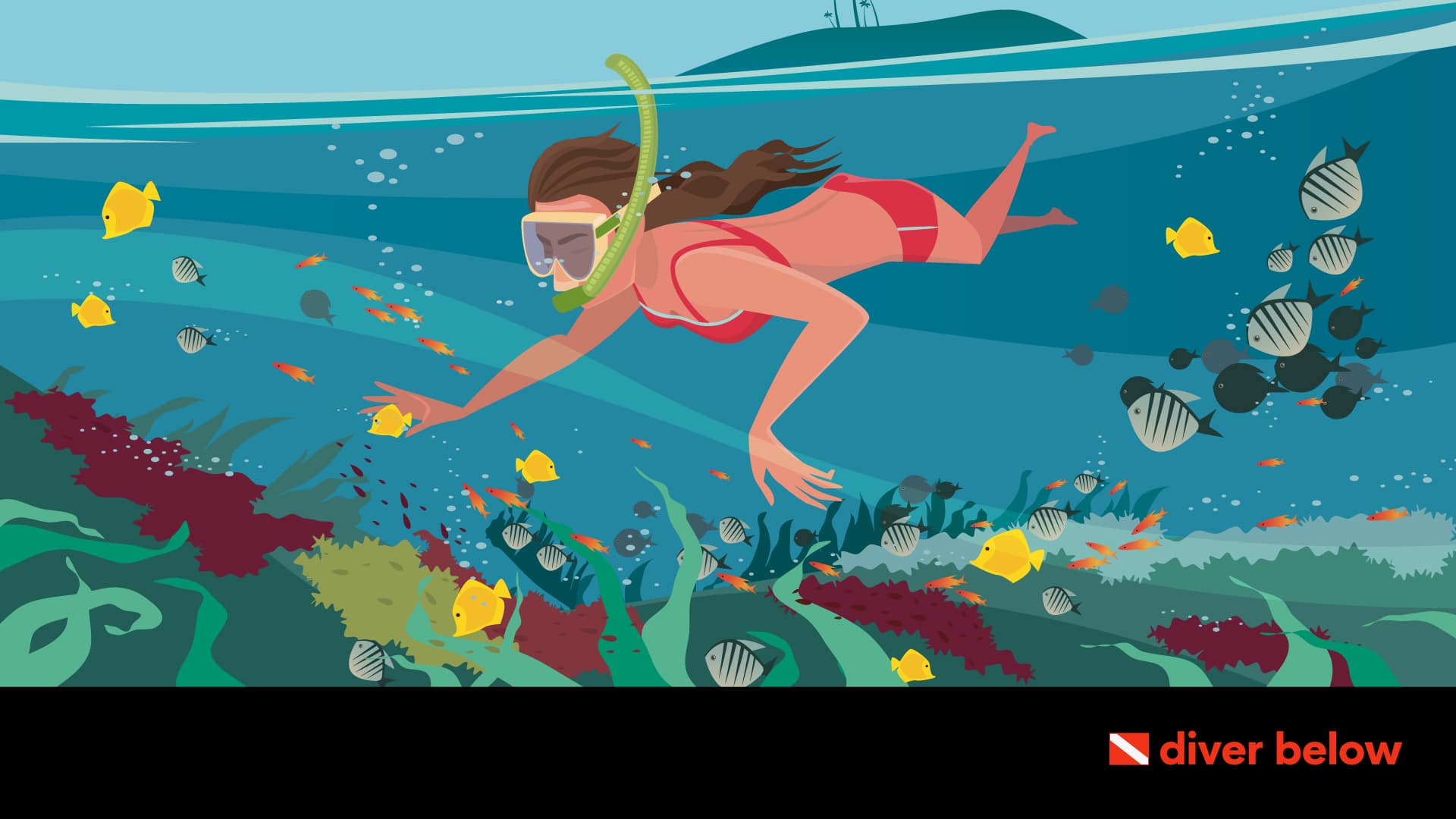
Rent Decent Gear
If you’ve decided to rent gear rather than purchase, you’ll want to make sure you’re using high-quality stuff.
Most importantly, the mask needs to fit correctly.
Otherwise, you might experience leaks while you’re snorkeling.
Check Equipment First
It doesn’t matter if you’ve rented or purchased gear.
You should always check the equipment before heading out to snorkel.
Checking your gear not only makes for a safer snorkeling experience, but it can help you prevent any unnecessary trips back to shore.
Control Breath and Stay Calm
Taking deep breaths is key to keeping yourself calm and relaxed as you go about your snorkeling expedition.
While you can get away with floating passively on the surface of the water as you observe tropical fish and other sea life beneath you, you’ll need to control your breath actively.
Float With Ease
Snorkeling can be as relaxing as you want it to be.
Just want to hang out at the surface for a pleasant, easy experience?
Make sure you wear a comfortable and well-fitting flotation device, such as an inflatable snorkeling vest or a life vest.
The vest should fit you snugly and not hang off your body.
Choose a Good Location
Doing a little research on where to go snorkeling can go a long way!
You probably won’t enjoy snorkeling in water that tends to be murky, so you’ll want to research areas that are known for having clear water.
It would be best if you also got to see the environment you’ll swim in beforehand, and ask yourself questions such as:
- What kinds of hazards do I need to be aware of here?
- Are there dangerous animals in this region?
- What will the water conditions and weather be like?
Relax and Enjoy
The best tip we can give anyone who wants to try snorkeling for the first time is to relax and enjoy yourself!
Things to Keep in Mind
To keep yourself and your environment safe, pay attention to these tips.
1. Don’t Touch Things
Hikers will be familiar with the slogan “leave no trace,” which encourages anyone to interact with or enjoy nature and to not take anything with them, leave anything behind, or alter the natural environment.
There’s no doubt that you’ll encounter incredible wildlife on a snorkeling adventure, but you mustn’t touch or take anything you see.
If you want a memento of your time underwater, you can take photos with a waterproof camera.
2. Don’t Snorkel Alone
Snorkeling is a relatively safe activity because you can easily avoid most risks.
However, snorkeling alone is never a good idea.
To stay safe, you should always take a buddy.
3. Understand Your Environment
Whether you’re snorkeling in an ocean or a lake, take some time to get to know the environment around you.
You can make a list of hazards you might encounter, including plant and animal life, so you’ll know what to do in case of an emergency.
You’ll also want to check the weather and water conditions for the day.
Safety Tips for Snorkeling
It’s easy to stay safe and have a fun time when snorkeling.
Follow these tips to get the most out of your experience.
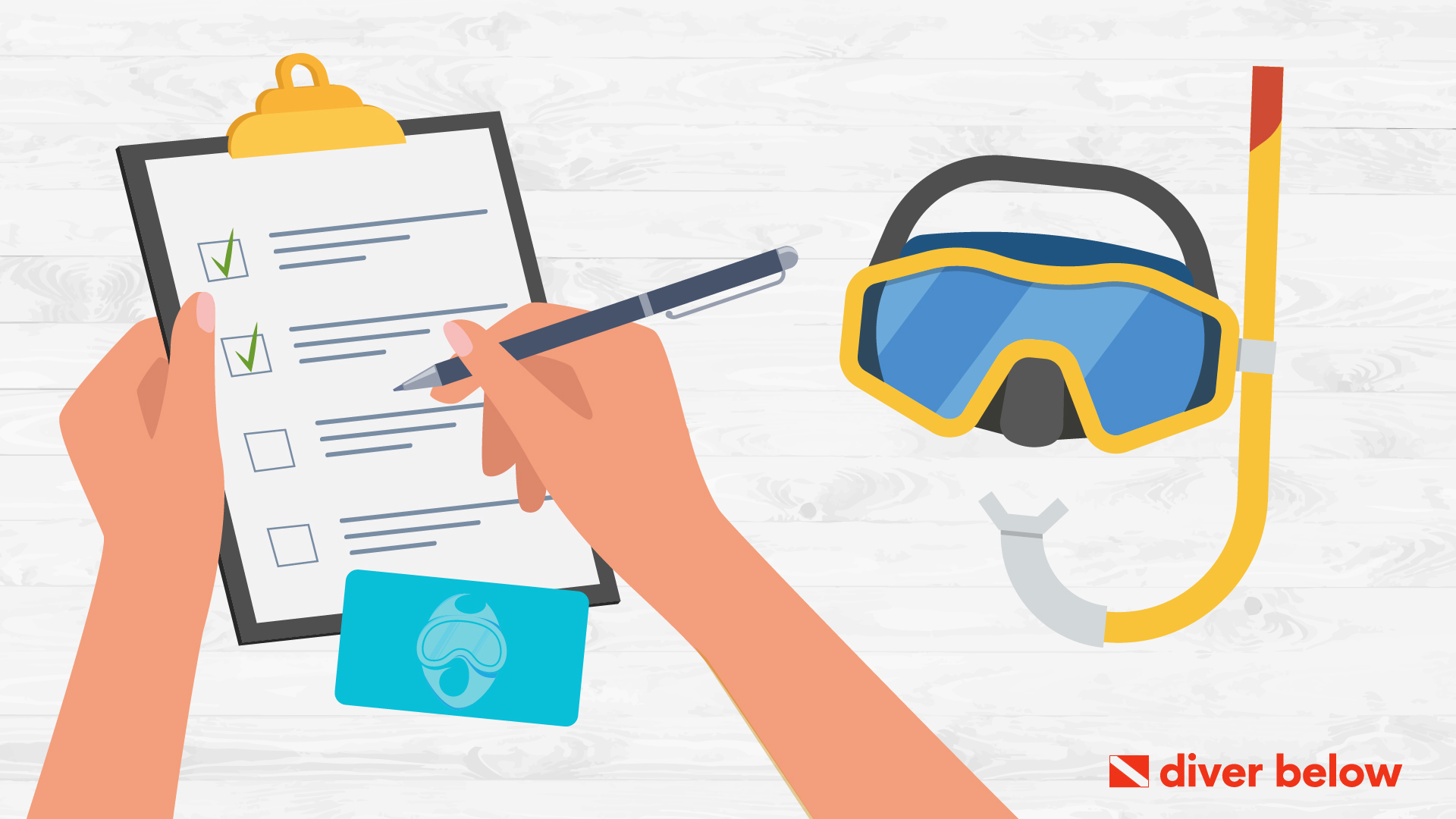
1. Snorkeling While Pregnant
Because you won’t be breathing in any compressed gases, it’s safe to snorkel while pregnant.
Anyone getting into water should be careful not to overexert themselves physically, pregnant women included.
2. Snorkeling While on Your Period
It’s perfectly safe to go snorkeling while on your period.
The idea that a shark or other predator in the ocean might attack you if you’re menstruating is a myth, albeit a scary one!
Sharks are far less interested in human blood than fish blood, and in fact, are most interested in fish gastric fluids than blood.
With that being said, if you see a shark, make sure to get back into your boat until it passes, unless you have a knowledgeable guide with you.
3. Snorkeling in the Rain
As long as the weather conditions allow for it, you can safely snorkel in the rain.
However, if the weather becomes cloudy, windy, or a storm rolls in, you should avoid snorkeling.
4. Snorkeling When Cloudy
A cloudy day can impair your visibility while snorkeling, which means bright or rich colors will usually appear or be muted.
Experts recommend avoiding snorkeling on very cloudy days.
Frequently Asked Questions
Do you still have a few questions about snorkeling?
Here are a few of the most frequently asked questions.
Where do I buy snorkeling gear?
There are tons of options when it comes to investing in your snorkeling gear!
Any large sporting store near you, like Dick’s Sporting Goods, likely has a snorkel section.
You can also search for scuba shops near you.
Lastly, you can order your gear from an online store.
Can snorkeling cause vertigo?
It’s possible to experience vertigo while snorkeling.
Some common causes of vertigo while snorkeling is sudden exposure of the ears to cold water, uneven exposure of water, and problems with equalization.
Wrapping Up
Snorkeling can be a fun family adventure on vacation or a great way to start taking underwater photos.
Whatever your reason for learning to snorkel, you’ll undoubtedly make memories to last a lifetime.
